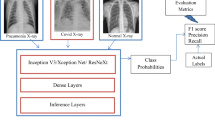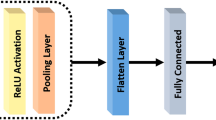Abstract
Most people who are infected with the COVID-19 virus show respiratory illness. As the virus is newly discovered, the world is not ready with an adequate number of testing kits so as to test each individual in the world. So, a different method that tells if a person may be infected or not will prove to be a big relief and will also help in decreasing the tension and fear among people. This problem can be solved by training machines using deep learning algorithms. The proposed CNN model takes input as chest X-ray images and predicts whether a person needs to go for COVID-19 testing or not. This will decrease the fear of being COVID-19 infected and can be easily implemented even in rural areas; which will also decrease the load of the COVID-19 testing team. At present, the COVID-19 tests are being done clinically through blood tests or nose/throat swab tests which requires around 24 h to give results. The proposed recommendation system takes around 35 min to give the result of a sample and curbs down the chances of virus spread through contact while testing, unlike the presently used methods. The experimental results yielded an accuracy of 97.62% using the chest X-ray scans and requires less computational time.
Access this chapter
Tax calculation will be finalised at checkout
Purchases are for personal use only
Similar content being viewed by others
References
Mortality Risk of COVID-19. https://ourworldindata.org/mortality-risk-covid, Accessed 24 Aug 2020.
Understanding of Convolutional Neural Network (CNN) – Deep Learning. https://medium.com/@RaghavPrabhu/understanding-of-convolutional-neural-network-cnn-deep-learning-99760835f148, Accessed 24 Aug 2020
S. Stirenko, Y. Kochura, O. Alienin, O. Rokovyi, Y. Gordienko, P. Gang, W. Zeng, in Chest X-ray analysis of tuberculosis by deep learning with segmentation and augmentation. IEEE International Conference on Electronics and Nanotechnology, Ukraine, pp. 422–428 (2018)
S. Sathiya, G. Priyanka, S. Jeyanthi, Detection of chronic obstructive pulmonary disease in computer aided diagnosis system with CNN classification. Int. J. Pure Appl. Math. 119(19), 13815–13821 (2018)
S. Asif, Y. Wen-hui, Automatic detection of COVID-19 using X-ray images with deep convolutional neural networks and machine learning. Med. Comput. Sci., 1–7 (2020)
L. Wang, Z.Q. Lin, A. Wong, COVID-Net: a tailored deep convolutional neural network design for detection of COVID-19 cases from chest X-ray images. Sci. Rep. 10, 1–2 (2020)
M. Shorfuzzaman, M. Masud, On the detection of COVID-19 from chest X-ray images using CNN-based transfer learning. Comput. Mater. Continua Tech Sci. Press 64(3), 1359–1381 (2020)
N.B. Muppalaneni, in Handwritten Telugu compound character prediction using convolutional neural network. IEEE International Conference on Emerging Trends in Information Technology and Engineering, India, pp. 1–4 (2020)
R. Kenins, Land cover classification using very high spatial resolution remote sensing data and deep learning. Latvian J. Phys. Tech. Sci. 57(1–2), 71–77 (2020)
A.K. Sahoo, C. Pradhan, H. Das, in Performance evaluation of different machine learning methods and deep-learning based convolutional neural network for health decision making. Nature Inspired Computing for Data Science (Springer, Heidelberg, 2020), pp. 201–212
A.E. Hassanien, A.B.M. Salem, R. Ramadan, T.H. Kim, in Advanced machine learning technologies and applications. International Conference on Advanced Machine Learning Technologies and Applications (Springer, Heidelberg, 2012). ISBN 978-3-642-35326-0.
A. Kumar, S. Sarkar, C. Pradhan, in Malaria disease detection using CNN technique with SGD, RMSprop and ADAM optimizers. Deep Learning Techniques for Biomedical and Health Informatics (Springer, Heidelberg, 2020), pp. 211–230
F. Shang, K. Zhou, H. Liu, J. Cheng, I.W. Tsang, L. Zhang, D. Tao, L. Jiao, VR-SGD: a simple stochastic variance reduction method for machine learning. IEEE Trans. Knowl. Data Eng. 32(1), 188–202 (2020)
M. Yaqub, J. Feng, M.S. Zia, K. Arshid, K. Jia, Z. Ur Rehman, A. Mehmood, State-of-the-art CNN optimizer for brain tumor segmentation in magnetic resonance images. Brain Sci. MDPI 10(7), 427 (2020)
A. Bhattacharjee, S.K. Borgohain, B. Soni, G.K. Verma, X.Z. Gao, in Machine learning, image processing, network security and data sciences. MIND (Springer, Hedielberg 2020). ISBN 978-981-15-6315-7
S. Dash, B.R. Acharya, M. Mittal, A. Abraham, A. Kelemen, Deep learning techniques for biomedical and health informatics (Springer, Heidelberg, 2020). ISBN 978-3-030-33966-1
G. Bebis, R. Boyle, B. Parvin, D. Koracin, C. Fowlkes, S. Wang, M.H. Choi, S. Mantler, J. Schulze, D. Acevedo, K. Mueller, M. Papka, in Advances in visual computing. International Symposium on Visual Computing, (Springer, Hedidelberg 2012). ISBN 978-3-642-33179-4
Hospitals Deploy AI Tools to Detect COVID-19 on Chest Scans. https://spectrum.ieee.org/the-human-os/biomedical/imaging/hospitals-deploy-ai-tools-detect-covid19-chest-scans, Accessed 12 Aug 2020
Covid-chestxray-dataset. https://github.com/ieee8023/covid-chestxray-dataset/tree/master/images, Accessed 10 Aug 2020
L. Barolli, M. Takizawa, F. Xhafa, T. Enokido, in Web, artificial intelligence and network applications. International Conference on Advanced Information Networking and Applications (WAINA), (Springer, Heidelberg, 2019). ISBN 978-3-030-15035-8
V.I. Perez-Neuno, A.S. Karaboga, M. Souchet, D.W. Ritchie, GES polypharmacology fingerprints: a novel approach for drug repositioning. J. Chem. Inf. Model. 54(3), 720–734 (2014)
A.M. Ud Din Khanday, S.T. Rabani, Q.R. Khan, N. Rouf, M.M. Ud Din, Machine learning based approaches for detecting COVID-19 using clinical text data. Int. J. Technol. 12(3), 731–739 (2020)
Author information
Authors and Affiliations
Editor information
Editors and Affiliations
Rights and permissions
Copyright information
© 2022 The Author(s), under exclusive license to Springer Nature Switzerland AG
About this chapter
Cite this chapter
Sinha, N., Karjee, P., Agrawal, R., Banerjee, A., Pradhan, C. (2022). COVID-19 Recommendation System of Chest X-Ray Images Using CNN Deep Learning Technique with Optimizers and Activation Functions. In: Nayak, J., Naik, B., Abraham, A. (eds) Understanding COVID-19: The Role of Computational Intelligence. Studies in Computational Intelligence, vol 963. Springer, Cham. https://doi.org/10.1007/978-3-030-74761-9_7
Download citation
DOI: https://doi.org/10.1007/978-3-030-74761-9_7
Published:
Publisher Name: Springer, Cham
Print ISBN: 978-3-030-74760-2
Online ISBN: 978-3-030-74761-9
eBook Packages: Intelligent Technologies and RoboticsIntelligent Technologies and Robotics (R0)




